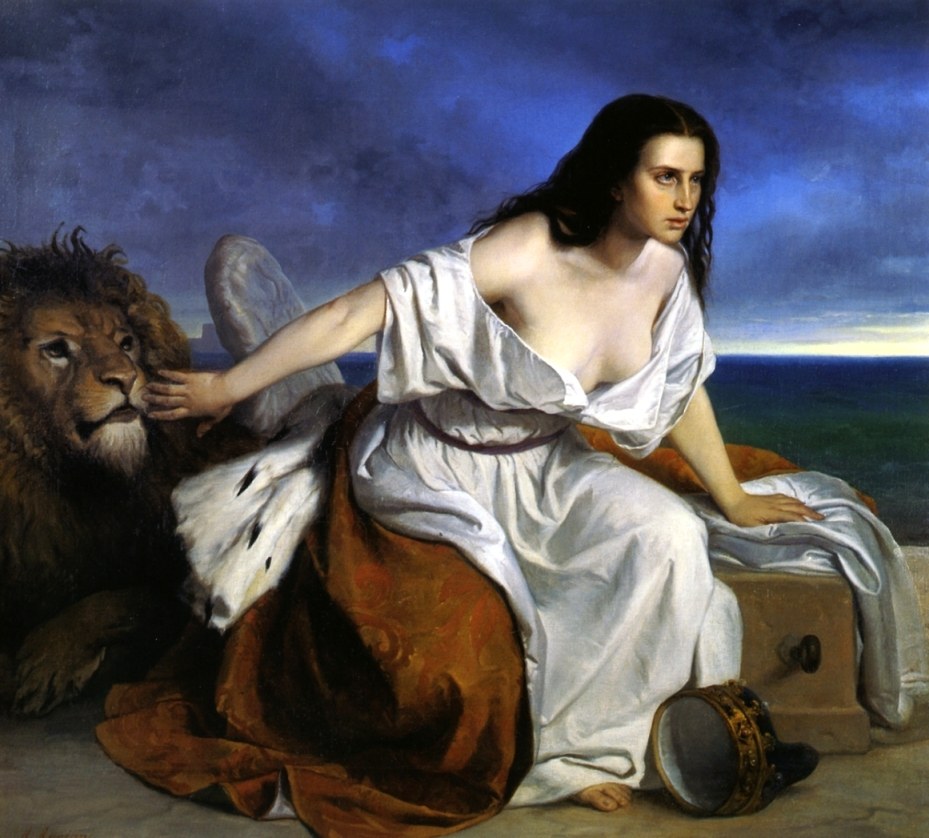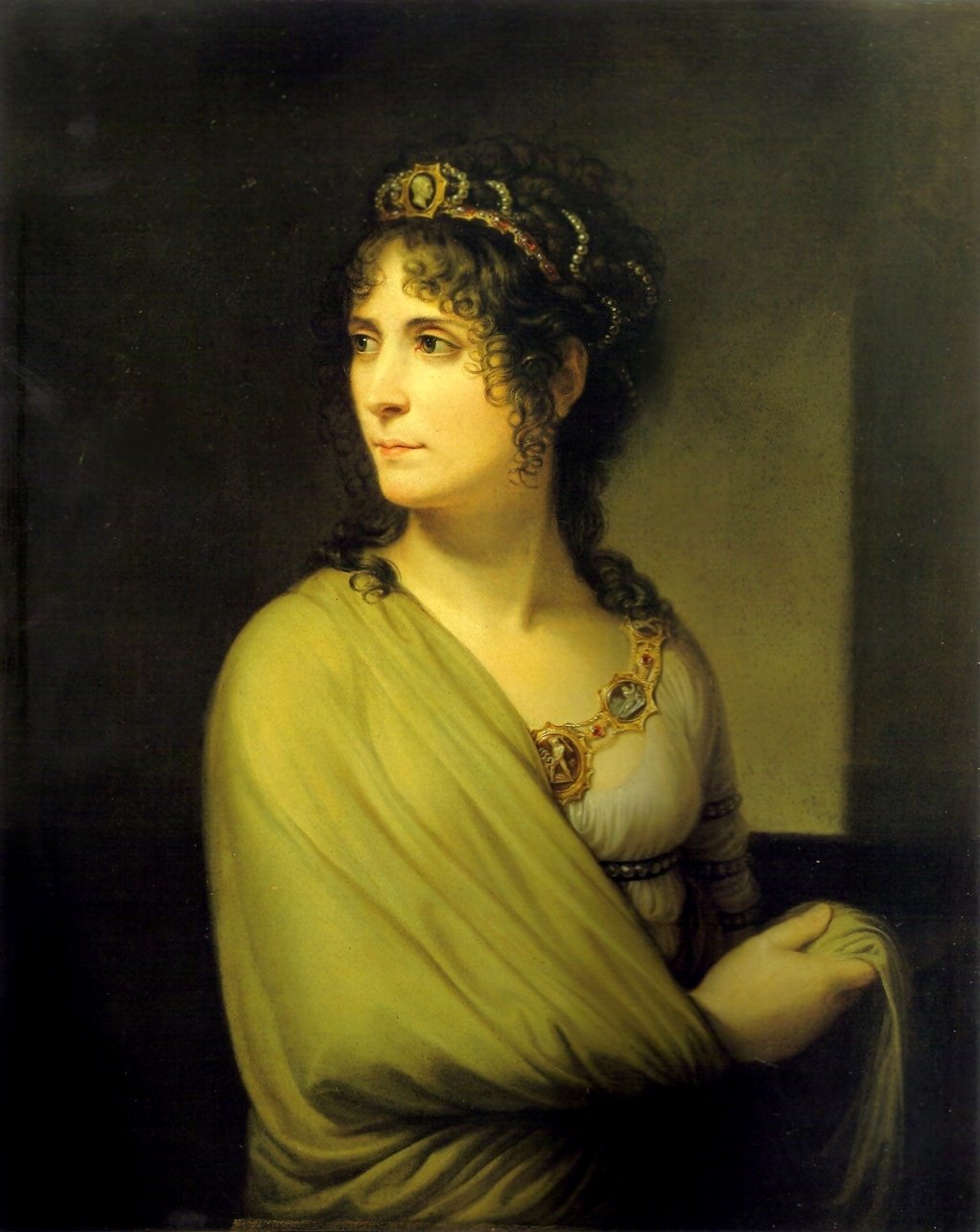Andrea Appiani
Venezia che spera
Andrea Appiani
Jupiter und Merkur bei Philemon
Andrea Appiani
Madame_Hamelin_
Andrea Appiani
Josephine
Andrea Appiani
Jonge Vrouw
 jonge vrouw.jpg)
Andrea Appiani
31 May 1754 – 8 November 1817
Biography
Andrea Appiani (31 May 1754 - 8 November
1817) was an Italian Neoclassical painter.
Born in Milan, it had been intended that
he follow his father's career in medicine
but instead entered the private academy of
the painter Carlo Maria Giudici(1723-1804)
where he received instruction in drawing,
copying mainly from sculpture and prints.
From there, he then joined the class of the
fresco painter Antonio de Giorgi, which was
held at the Ambrosiana picture gallery in
Milan. At the same time, he also frequented
the studio of Martin Knoller, where his knowledge
of painting in oils was deepened. Also, he
studied anatomy at the Ospedale Maggiore
in Milan with the sculptor Gaetano Monti.
Appiani's interest in aesthetic issues was
stimulated by the classical poet Giuseppe
Parini, whom he drew in two fine pencil portraits.
In 1776 he entered the Brera Academy of Fine
Arts to follow the painting courses of Giulio
Traballesi, receiving a mastery of the fresco
technique. Among his masterpieces are the
frescoes depicting the four evangelists and
doctors of the church that he painted for
the cupola and pendentives for the church
of Santa Maria presso San Celso in 1795 and
the fresco with The Parnassus, representing
Apollo and the Muses, on the ceiling of the
dining room of Royal Villa of Milan. Another
masterpiece are the frescoes depicting Allegories
of Virtues and others honoring Napoleon in
the rooms of the Royal Palace of Milan.
Although created a pensioned artist to the
Kingdom of Italy by Napoleon, Appiani lost
his allowance after the events of 1814 and
fell into poverty. During his period as court
painter he rendered portraits of Napoleon
and the chief personages of his regime, among
the most graceful of which are his oil paintings
Venus and Love, and Rinaldo in the garden
of Armida. He is known as "the elder",
to distinguish him from his great-nephew
Andrea Appiani, an historical painter at
Rome. Other painters of the same name were
Niccolò Appiani and Francesco Appiani.
Appiani painted a large canvas of the Encounter
of Rachel and Jacob for a church in Alzano.The
Brera has a fresco by Appiani representing
Olympus.
He died at Milan in 1817. Among his pupils
are Antonio De Antoni,Carlo Prajer, Angelo
Monticelli and Giuseppe Bossi.
THE NEOCLASSICISM
Neoclassicism (sometimes rendered as Neo-Classicism
or Neo-classicism) is the name given to quite
distinct movements in the visual arts, literature,
theatre, music, and architecture. These movements
were in effect at various times between the
18th and the 20th centuries. What could these
"neoclassicisms" have in common?
What "neo"-classicism depends on
most fundamentally is a consensus about a
body of work that has achieved canonic status.
These are the "classics." Ideally?
and neoclassicism is essentially an art of
an ideal? an artist, well-schooled and comfortably
familiar with the canon, does not repeat
it in lifeless reproductions, but synthesizes
the tradition anew in each work. This sets
a high standard, clearly; but though a neoclassical
artist who fails to achieve it may create
works that are inane, vacuous or even mediocre,
gaffes of taste and failures of craftsmanship
are not commonly neoclassical failings. Novelty,
improvisation, self-expression, and blinding
inspiration are not neoclassical virtues;
neoclassicism exhibits perfect control of
an idiom. It does not recreate art forms
from the ground up with each new project,
as modernism demanded. "Make it new"
was the modernist credo of the poet Ezra
Pound.
Speaking and thinking in English, "neoclassicism"
in each art implies a particular canon of
"classic" models. We recognize
them, even if we struggle against their power:
Virgil, Raphael, Nicholas Poussin, Haydn.
Other cultures have other canons of classics,
however, and a recurring strain of neoclassicism
appears to be a natural expression of a culture
at a certain moment in its career, a culture
that is highly self-aware, that is also confident
of its own high mainstream tradition, but
at the same time feels the need to regain
something that has slipped away: Apollonius
of Rhodes is a neoclassic writer; Ming ceramics
pay homage to Sung celadon porcelains; Italian
15th century humanists learn to write a "Roman"
hand we call italic (a.k.a. Carolingian);
Neo-Babylonian culture is a neoclassical
revival, and in Persia the "classic"
religion of Zoroaster, Zoroastrianism, is
revived after centuries, to "re-Persianize"
a culture that had fallen away from its own
classic Achaemenean past.
In the visual arts the European movement
called "neoclassicism" began after
ca 1765, as a reaction against both the surviving
Baroque and Rococo styles, and as a desire
to return to the perceived "purity"
of the arts of Rome, the more vague perception
("ideal") of Ancient Greek arts
(where almost no western artist had actually
been) and, to a lesser extent, 16th century
Renaissance Classicism.
Each "neo"- classicism selects
some models among the range of possible classics
that are available to it, and ignores others.
The neoclassical writers and talkers, patrons
and collectors, artists and sculptors of
1765 - 1830 paid homage to an idea of the
generation of Pheidias, but the sculpture
examples they actually embraced were more
likely to be Roman copies of Hellenistic
sculptures. They ignored both Archaic Greek
art and the works of Late Antiquity. The
Rococo art of ancient Palmyra came as a revelation,
through engravings in Wood's The Ruins of
Palmyra. Even in all-but-unvisited Greece,
a rough backwater of the Ottoman Empire,
dangerous to explore, neoclassicists' appreciation
of Greek architecture was mediated through
drawings and engravings, which subtly smoothed
and regularized, "corrected' and "restored"
the monuments of Greece, not always consciously.
As for painting, Greek painting was utterly
lost: neoclassicist painters imaginatively
revived it, partly through bas-relief friezes,
mosaics, and pottery painting and partly
through the examples of painting and decoration
of the High Renaissance of Raphael's generation,
frescos in Nero's Domus Aurea, Pompeii and
Herculaneum and through renewed admiration
of Nicholas Poussin. Much "neoclassical"
painting is more classicisizing in subject
matter than in anything else.
There is an anti-Rococo strain that can be
detected in some European architecture of
the earlier 18th century, most vividly represented
in the Palladian architecture of Georgian
Britain and Ireland, but also recognizable
in a classicizing vein of architecture in
Berlin. It is a robust architecture of self-restraint,
academically selective now of "the best"
Roman models.
Neoclassicism first gained influence in England
and France, through a generation of French
art students trained in Rome and influenced
by the writings of Johann Joachim Winckelmann,
and it was quickly adopted by progressive
circles in Sweden. At first, classicizing
decor was grafted onto familiar European
forms, as in the interiors for Catherine
II's lover Count Orlov, designed by an Italian
architect with a team of Italian stuccatori:
only the isolated oval medallions like cameos
and the bas-relief overdoors hint of neoclassicism;
the furnishings are fully Italian Rococo.
But a second neoclassic wave, more severe,
more studied (through the medium of engravings)
and more consciously archaeological, is associated
with the height of the Napoleonic Empire.
In France, the first phase of neoclassicism
is expressed in the "Louis XVI style",
the second phase in the styles we call "Directoire"
or "Empire." Italy clung to Rococo
until the Napoleonic regimes brought the
new archeaological classicism, which was
embraced as a political statement by young,
progressive, urban Italians with republican
leanings.
The high tide of neoclassicism in painting
is exemplified in early paintings by Jacques-Louis
David (illustration, right) and Jean Auguste
Dominique Ingres' entire career. David's
Oath of the Horatii was painted in Rome and
made a splash at the Paris Salon of 1784.
Its central perspective is perpendicular
to the picture plane, made more emphatic
by the dim arcade behind, against which the
heroic figures are disposed as in a frieze,
with a hint of the artificial lighting and
staging of opera, and the classical coloring
of Nicholas Poussin.
Neoclassicism continued to be a major force
in academic art through the 19th century
and beyond? a constant antithesis to Romanticism
or Gothic revivals? although from the late
19th century on it had often been considered
anti-modern, or even reactionary, in influential
critical circles. By the mid-19th century,
several European cities - notably St Petersburg
and Munich - were transformed into veritable
museums of Neoclassical architecture
THE NEOCLASSICISM
IN ARTE EST LIBERTAS
MOVEMENTS-ARTISTS


_Jupiter_und_Merkur_bei_Philemon_und_.jpg)


 jonge vrouw.jpg)

